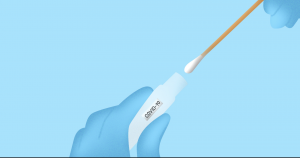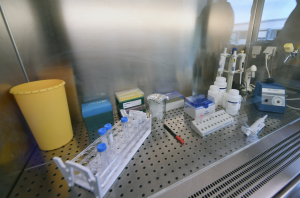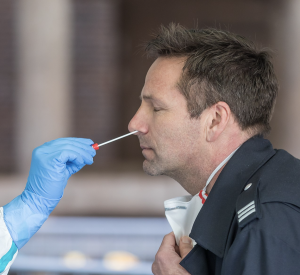18
Alexis Duran
Introduction
Keywords
- COVID-19
- World Health Organization
- testing
- diagnostic test
- SARS-CoV-2
Learning Objectives
- Recognize how science and technology have engaged in the coronavirus pandemic
- Differentiate between the types of COVID-19 tests
- Determine the improvements of accuracy and time of diagnostic test results
- Understand how the society is giving numerous amounts of tests in convenient, commodious ways
- Establish the societal duties that come with COVID-19 testing
The never seen before coronavirus COVID-19 pandemic has been the defining health emergency in the 21st century, affecting every continent except Antarctica. On January 30th, 2020, the World Health Organization(WHO, 2020) announced the outbreak as a Public Health Emergency of International Concern. As of September 20, according to the CDC (Al Jazeera, 2020), 957,000 people from all of the globe have passed and there have been more than 30.8 million cases and more to come. This outbreak has affected all aspects of the society. We have seen the world go into complete chaos with record breaking lows and highs that never seem to stabilize.
Yet, how are we able to catch and take account of all the cases arising? Testing for the SARS-CoV-2 (severe acute respiratory syndrome coronavirus 2) determines whether a patient has or doesn’t have coronavirus. The purpose of these diagnostic tests allows the population to be knowledgeable to quarantine or perceive if they have been exposed to the dangerous strain or not. Testing is highly significant to stopping the spread and going back to normal. As of right now there are two types of tests that can detect the virus.
Science and technology has had a vast involvement when dealing with this pandemic. It deals with the playing out of the diagnostic tests. As of right now there are two types of tests that can detect the virus. Hundreds and thousands of people get tested a day, making scientists in laboratories as busy as ever. Almost every aspect of diagnostic tests have been adjusted to comply with this new virus that is killing so many people everyday. We have never seen this many tests being taken and shipped off to detect the strain. The different types of tests, increased amounts of tests given, the improvements on accuracy and time to get results, and society doing their job to test are all dominant factors in COVID-19 testing that affect society. This chapter acknowledges the changes of society due to COVID-19 testing and explains the impact. COVID-19 testing is impacting society positively due to different types of tests, increased amount of tests given, and improvements on accuracy and time given to get results back.
The Different types of COVID-19 tests
Key Takeaway
Understanding the different types of COVID-19 diagnostic tests is essential when exposed or infected. This section will breakdown the variety of tests and describe the science and technology involved in determining if infected or not. It will also contribute to your understanding in which circumstances are they applicable
Understanding the different types of COVID-19 diagnostic tests is essential when exposed or infected. This section will breakdown the variety of tests and describe the science and technology involved in determining if infected or not. It will also contribute to your understanding in which circumstances are they applicable.
For many, testing is not everyone’s favorite thing to do in the world but it is their responsibility to test in order to stop the global health crisis. Unless you are a highly educated, well-certified biologist, scientist or doctor, it is not common to know every detail about testing this new virus that has little evidence on. We are presented with new questions that are demanding answers to. What am I being tested for? How am I being tested? What testing is available? All these questions can be answered in this section to help guide you through this new way of life that we currently are living.
To start off, according to Patel (2020), “There are two broad categories of SARS-CoV-2 tests: those that detect the virus itself and those that detect the host’s response to the virus”(p.1). The difference between the tests is one is a molecular test and the other is an antigen test.

“Covid-19 testing” by Prachatai is licensed under CC BY-ND 2.0
The second type of test are antibody tests. Specific proteins are detected from a virus particle with the antigen tests (FDA, 2020). The sample is acquired through a blood test. According to the American Society of Microbiology (2020), this test is based on the development of antibodies from the response of the infection. Since this type of test uses serology it takes between 7 to 11 days to develop antibodies. Antibody testing is not as effective as molecular testing in the circumstance of an acute illness. What this test does is usually indicate immunity to the virus. When someone with covid recovers, they produce antibodies from working B-cells that allow protection against the infectious strain (Rasmussen, 2020). Furthermore, antibody tests show that you’ve had the SARS-CoV-2 strain but don’t specify the timeline. These types of tests are more useful when discussing the immunity to covid.
COVID-19 testing is quick and easy, no one should come up with the excuse that testing is inconvenient to the society. Scientists have altered diagnostic tests to the best of their ability and used the finest technology to be successful. It is profoundly substantial that this information is learned to guide you through these difficult times but it is important to stay safe and healthy.
Improvements on Accuracy and Time to get Results
Key Takeaway
Explanation on how covid test results come back accurate and fast. With such high numbers of cases, results need to be sent out to patients in record time in order to trace those who they have been in contact with and begin quarantining.
With testing, there always comes results. Now that we understand the difference between the two types of corona tests, it is key to understanding the accuracy and time to get the results. Results are just as significant as getting the correct test. However, if results take a prolonged period to get back to you, time will already be up to quarantine, making the speed of results highly vital. Yet, what technologies are used to increase the time interval? How do we know if these results are accurate? These questions will be answered in this section .
There can be many factors that can increase the speed of reviewing diagnostic tests. Dr. Alexis Nahama at the biotech company, Sorrento Therapeutics Inc. says that you can’t just increase the amount of PCR machines to make time go faster (Radclifffe, 2020). Sorrento Therapeutics are working on a rapid test that can detect the RNA in as little as 30 minutes from a saliva sample. The color of the fluid would change colors to yellow if positive. The unique component about this test is Sorrento wants to make this test available in a doctor’s office, school, hotel check-in, or even before getting on an airplane.
Once your sample has arrived at a laboratory, in theory it should only take a few hours to find the SARS-CoV-2 strain. A great deal of the time is sending it back, depending on where you got the test and how many tests were administered at that location (Martin, 2020).

“COVID-19 Testing (05810978)” by Dean Calma / IAEA is licensed under CC BY 2.0
Results of COVID-19 tests are prominently displayed as accurate. A minority of diagnostic tests detecting the SARS-CoV-2, come back as a false positive or false negative. A measure of how well an individual assay detects the RNA molecules or viral protein is defined as test sensitivity. The principle of acquiring the highest sensitivity is evolved around the concept of repeating the given test to where laboratories cannot give inaccurate results. Test sensitivity is not determined by how well molecules are found in the sample given from the patient (Mina, 2020). In June 2020, the Centers for Disease Control and Prevention (CDC) made the impression that there were 10 times as many coronavirus cases in the United State as being detected. Strictly speaking, regardless of elite analytical sensitivity , the testing regimens are still failing to detect infections and failing as covid filters (Mina,2020). This virus is so dangerous not every case can be caught, prolonging the stop of this pandemic.
Sonja Hartnack (2020), wrote a journal article about a study where scientists thought it was possible to “demonstrate that a new test might be better than the old-test”. The study used Bayesian latent class models that approximates the sensitivity of the test. The results of the study concluded that they were confident that the BLCMs allowed sensitivities and specificities in a way that was unbiased without the gold standard (Hartnack, 2020). Overall, the new tests are better than the old-test based on accuracy.
Increased Amounts of Tests Given
Key Takeaway
Knowingness of what the government and health officials are doing to provide as many COVID-19 tests. Diagnostic tests are a hot commodity, it is imperative not limit who can be accessible to these tests.
The coronavirus pandemic has reached the catastrophic milestone of a million deaths. Diagnostic tests are essential to not letting any more families go through suffering of losing a loved one from COVID-19. How are we getting the immense amounts of tests so easily?
The congress has lended $1.5 billion for SARS-CoV-2 testing to the National Institutes of Health (NIH). The NIH has been engaged in collaborative efforts with developing a vaccine, diagnostic tests, and etc. Starting with the Rapid Acceleration of Diagnostics (RADx) program, that focuses on the deployment of conscientious, rapid, reliable diagnostic tests all over the country. This program has helped with the initiative to expand test capacity and allow 2% of the U.S. population or 6 million to test per day (Tromberg, 2020).
In addition to the RADx program, the COVID Tracking Project also views the test capacity occurring in the US. This project is effective to report the number of tests performed and number of patients tests are performed on (John Hopkins, 2020). The tracking of this project is useful to determine numbers applicable to the stop the stead of COVID-19.
The journalist, Rich Kremer (2020) notes that Winsconsin health providers say the covid testing supply chains are increasing and improving, in which this allows the state’s test capacity to grow. COVID-19 testing is improving due to the U.S. Department of Health and Human Services (HHS) partnership with national pharmacies and grocery retail chains (Washington, 2020). You have most likely seen your local CVS, Walgreens, Rite-Aid, etc and saw the signs that say “free drive-though covid test”. This partnership has made covid testing a blessing to a range of people, it does not limit to anyone. It provides covid testing to be convenient and helps out the retailers during these hard times. The community can access diagnostic tests at any time to ensure they do not spread the disease any more than it has.
Society Must Do Their Job by Testing
Key Takeaway
Comprehension of society and people doing their part in testing. Many may be opposed to testing but it is necessary for the health and safety of others.
Comprehension of society and people doing their part in testing. Many may be opposed to testing but it is necessary for the health and safety of others.
All over the world, everyone is trying to adapt the best they can to try to make life as normal as possibly. Although many strive to remain normal, they don’t take into account the idea of testing regularly. The record numbers of positive cases over the 2019-2020 span of coronavirus events indicate that some individuals and small groups are not participating in testing and diagnosis. It may be that others are not knowledgeable or it may be the stubbornness and inconsiderateness or not thinking of others lives and intention to end this pandemic. Despite the fact that we have people in this society who complain and aren’t taking coronavirus seriously, it is important to use this section and apply it to your life or get the word out.
Testing should be considered if showing symptoms, have been exposed, referred by a healthcare provider, part of a cohort for whom testing is recommended, attending IHE that require entry screening, and etc (Centers of Disease Control and Prevention, 2020). If those apply to you or any individual it is imperative to test.
COVID-19 can affect certain people in different ways. The virus indicates that symptoms appear from a span of 2-14 days after exposure, making it even more difficult to contain the virus from getting spread. Some may be symptomatic and show symptoms, allowing it to be an easier indication to get tested. Those symptoms include fever or chills, cough, shortness of breath or difficulty breathing, muscle or body aches, headache, new loss of taste or smell, sore throat, congestion or runny nose, nausea or vomiting or diarrhea (Mayo Clinic, 2019). Symptoms may also be mild or severe depending on the individual’s body. While others are asymptomatic, showing no symptoms but have the virus in their system. With this virus, it is advised to test daily or regularly (Mateo, 2020).

“Demonstration of a nasopharyngeal swab for COVID-19 testing” by Raimond Spekking is licensed under CC BY-SA 4.0
Chapter Summary
- Acknowledging the different types of COVID-19 diagnostic tests, furthers your comprehension of what tests are available, what test you should take, and the science behind testing for SARS-CoV-2.
- Explaining what goes into accurate and rapid testing. Science and technology are key points to allow the flow of the coronavirus testing process.
- Many programs and institutions are offering their money and help to give out as many tests as possible. Enormous numbers of positive cases and deaths are increasing the tests needed.
- Society needs to do their job to stop the spread of this pandemic. Not only do we need to wear masks, social distance, and wash your hands, we need to test regularly to be safe
Review Questions
Match the correct words together
1. Molecular tests a) New strain of coronavirus
2. Antibody tests b) Tests that detect the virus itself
3. SARS-CoV-2 c) Tests that detect the host’s response to the virus
4. A group of friends, Noah, Ian, and Cole went out to a party on Saturday, Halloween night. Cole and Ian tested positive for coronavirus on Monday. Noah tested positive but has no symptoms. Why did this happen?
5. What is test sensitivity?
Answers
- B
- C
- A
- Noah is asymptomatic or his symptoms have not appeared yet.
- Test sensitivity is the measure of how well an individual assay detects the RNA molecules or viral protein.
References
Al Jazeera. (2020, September 20). Coronavirus: All you need to know in under 500 words. Retrieved November 17, 2020, from https://www.aljazeera.com/news/2020/09/20/coronavirus-all-you-need-to-know-in-under-500-words/
Ashley Mateo November 02, & Mateo, A. (2020, November 02). This Is How Often You Should Be Getting Tested for COVID, According to Experts. Retrieved November 17, 2020, from https://www.health.com/condition/infectious-diseases/coronavirus/covid-testing
Commissioner, O. (2020). A Closer Look at COVID-19 Diagnostic Testing. Retrieved November 17, 2020, from https://www.fda.gov/health-professionals/closer-look-covid-19-diagnostic-testing
Commissioner, O. (2020). A Closer Look at COVID-19 Diagnostic Testing. Retrieved November 17, 2020, from https://www.fda.gov/health-professionals/closer-look-covid-19-diagnostic-testing
Commissioner, O. (n.d.). A Closer Look at COVID-19 Diagnostic Testing. Retrieved November 17, 2020, from https://www.fda.gov/health-professionals/closer-look-covid-19-diagnostic-testing
Conner, K. (2020, October 02). COVID: When to get tested for the coronavirus and how long it will take to get results. Retrieved November 17, 2020, from https://www.cnet.com/health/covid-when-to-get-tested-for-the-coronavirus-and-how-long-it-will-take-to-get-results/
Coronavirus disease 2019 (COVID-19). (2020, November 13). Retrieved November 17, 2020, from https://www.mayoclinic.org/diseases-conditions/coronavirus/symptoms-causes/syc-20479963
Daily Testing Trends in the US – Johns Hopkins. (n.d.). Retrieved November 17, 2020, from https://coronavirus.jhu.edu/testing/individual-states
Mina, M., Author AffiliationsFrom the Harvard T.H. Chan School of Public Health, J. H. Beigel and Others, L. A. Jackson and Others, & A. G. Letizia and Others. (2020, November 05). Rethinking Covid-19 Test Sensitivity – A Strategy for Containment: NEJM. Retrieved November 17, 2020, from https://www.nejm.org/doi/full/10.1056/NEJMp2025631
Our immune systems can cope with Covid-19 – it’s our politicians who can’t | Angela Rasmussen. (2020, November 15). Retrieved November 17, 2020, from https://www.theguardian.com/commentisfree/2020/nov/15/immune-systems-covid-19-politicians-virus
Patel, R., Babady, E., Theel, E., Storch, G., Pinsky, B., George, K., . . . Bertuzzi, S. (2020, April 28). Report from the American Society for Microbiology COVID-19 International Summit, 23 March 2020: Value of Diagnostic Testing for SARS–CoV-2/COVID-19. Retrieved November 17, 2020, from https://mbio.asm.org/content/11/2/e00722-20
Radcliffe, S. (2020, August 26). Here’s Why We Can’t Rely on Rapid Coronavirus Testing. Retrieved November 17, 2020, from https://www.healthline.com/health-news/fast-isnt-always-better-experts-worry-about-rise-of-rapid-covid-19-testing
Testing, Screening, and Outbreak Response for Institutions of Higher Education (IHEs). (n.d.). Retrieved November 17, 2020, from https://www.cdc.gov/coronavirus/2019-ncov/community/colleges-universities/ihe-testing.html
Tromberg, B., Al., E., Author AffiliationsFrom the National Institute of Biomedical Imaging and Bioengineering (B.J.T.), J. H. Beigel and Others, A. G. Letizia and Others, & L. A. Jackson and Others. (2020, November 05). Rapid Scaling Up of Covid-19 Diagnostic Testing in the United States – The NIH RADx Initiative: NEJM. Retrieved November 17, 2020, from https://www.nejm.org/doi/full/10.1056/NEJMsr2022263
(n.d.). Retrieved November 17, 2020, from https://academic-oup-com.libproxy.clemson.edu/clinchem/article/66/5/664/5741389
(n.d.). Retrieved November 17, 2020, from https://onlinelibrary-wiley-com.libproxy.clemson.edu/doi/full/10.1002/jmv.26405
